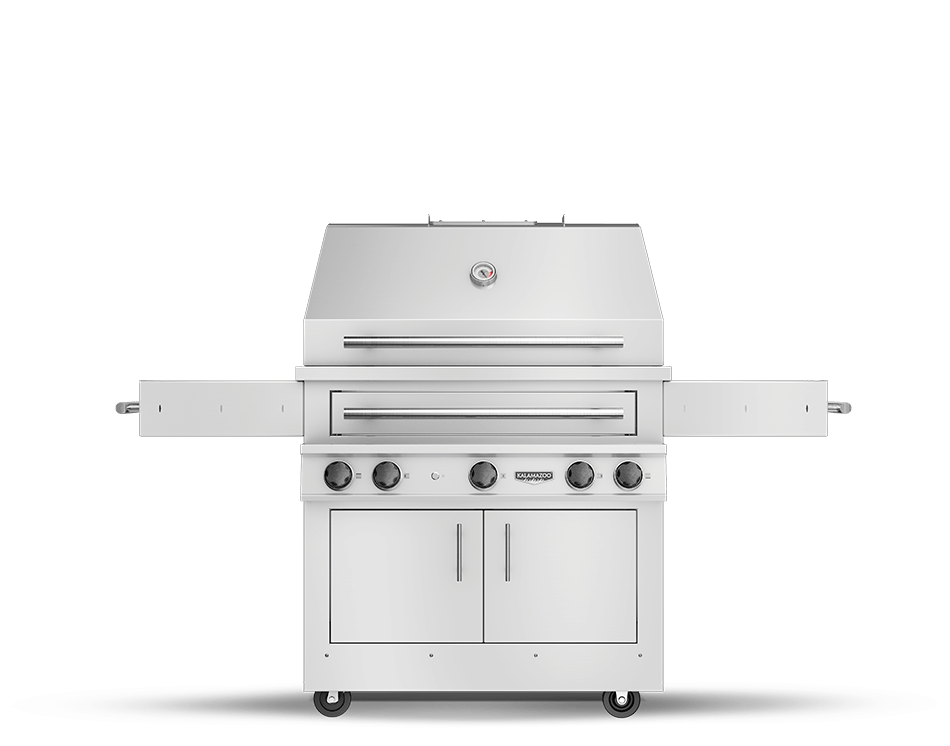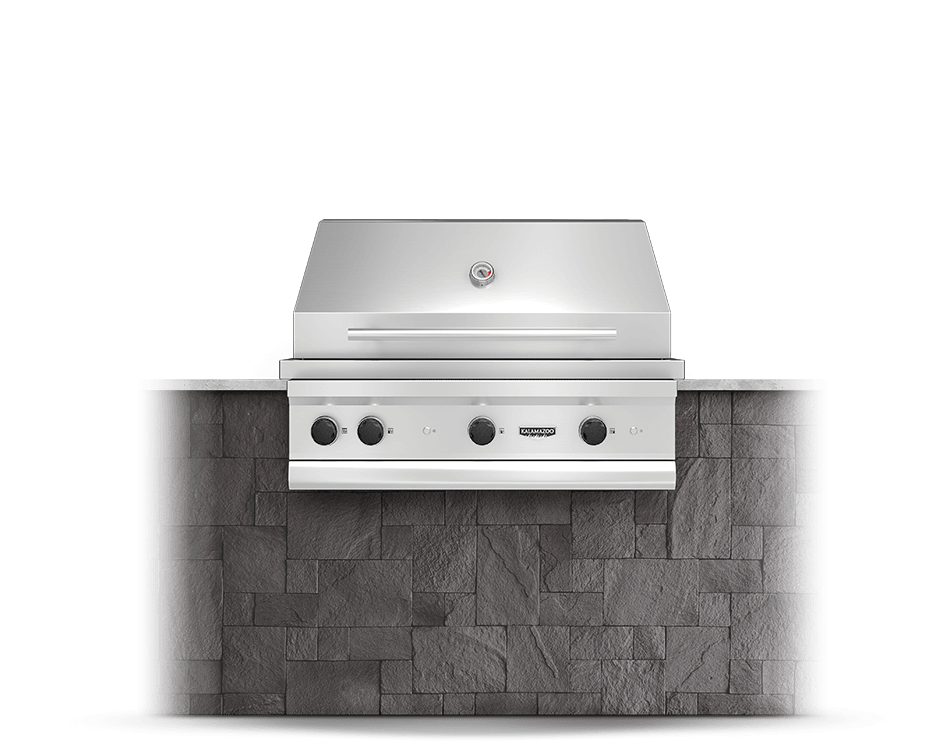
One of the greatest benefits of owning a Kalamazoo grill is the rotisserie; it makes it possible to roast meat over a flavorful live wood fire. You can find basic instructions in our Guide to Rotisserie Grilling, but this grilling guide will offer tips and tricks specifically for roasting a whole suckling pig. Suckling pig is just about the most succulent meat you can roast on the grill, and well worth the effort. The meat is juicy and flavorful, and, following these instructions, the skin will be crispy and beautifully browned.
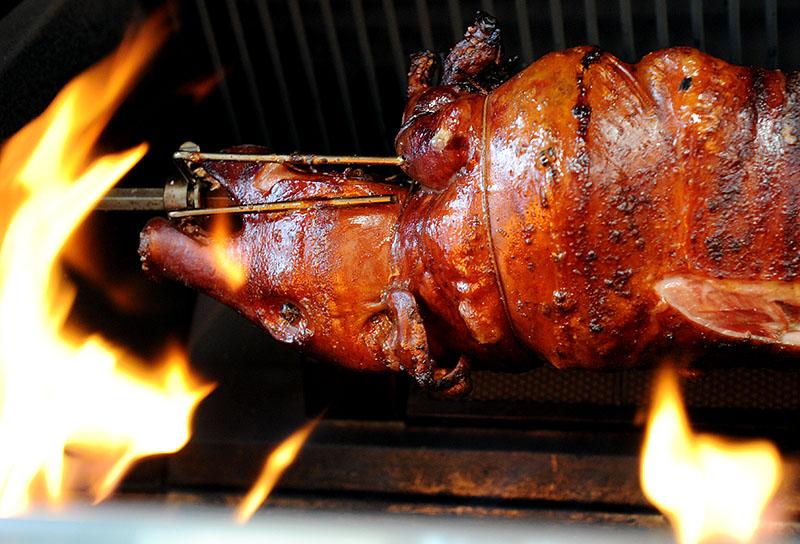
What size pig should I use?
For any Kalamazoo grill other than our smallest series, the K500 Series, we recommend cooking a 20-pound pig. Plan on 1 ½ pounds of suckling pig per guest, so a 20-pound suckling pig should yield enough delicious meat to serve 12 to 14 people.
The usable rotisserie spit length for each Kalamazoo grill series is listed below. The lengths shown factors in the space needed for the rotisserie forks, and for mounting into the grill. Please note the overall length of each rotisserie spit is longer than the usable length listed below. A 20-pound suckling pig is about 24 inches long when trussed. Suckling pigs are available as small as 12 pounds.
Usable Rotisserie Spit Lengths by Kalamazoo Grill Series:
- K1000 Series Hybrid Fire Grills – 43 inches
- K750 Series Hybrid Fire Grills – 30 inches
- K500 Series Hybrid Fire Grills – 20 inches
- Gaucho Series Grills – 30 inches
In addition to thinking about the length of the rotisserie spit, you need to be aware of the maximum diameter that allows for enough clearance as the food rotates inside the grill. The maximum diameter for each grill series is listed below.
Maximum Diameter for Rotisserie Cooking by Grill Series:
- Hybrid Fire Grills – 14 inches
- Gaucho Grills – 19 inches
The motorized rotisserie systems on Kalamazoo Hybrid Fire Grills and Gaucho Grills are suitable for handling up to 40 pounds of food when the food is properly trussed and centered on the spit.
Where should I purchase a suckling pig?
With enough notice, many independent butchers are able to order a suckling pig for you. You will want to be specific about the size, and you should confirm with the butcher that all of the hair will be removed and it will be ready for cooking. At Kalamazoo, we order our suckling pigs from McReynolds Farms in Arizona and highly recommend them. We suggest ordering by phone, as their staff is very helpful and knowledgeable.
How do I mount the pig on the spit?
While it may seem like a daunting task, mounting a suckling pig onto the rotisserie spit is not too difficult if you follow these tips:
- You will need 3 rotisserie forks. Place one of the forks in a bench vice and squeeze the prongs together into 2 pairs. This modification is helpful for sliding the forks into the mouth. If you do not have a bench vice, or if you need another rotisserie fork, the Kalamazoo customer service team is happy to help. We can make the modification for you before shipping.
- If the pig is already trussed or tied, remove all of this.
- Generously season the inside of the pig with kosher salt.
- Loosen the thumb screw, and place an unmodified rotisserie fork in the central cavity of the pig with the forks pointed toward the tail. This fork, once mounted, will support the middle of the pig and help keep it balanced on the spit.
- Slide the rotisserie spit through the tail end of the pig, then through the rotisserie fork in the central cavity, then out the mouth. With the pig roughly centered on the spit, slide the fork in the central cavity forward about as far as it can go. Hand-tighten the thumb screw to get it locked into this position, then slide the spit rearward so you can more easily get at the fork. Use a pair of pliers to fully-tighten the thumb screw, then slide the spit forwards once again to re-center the pig.
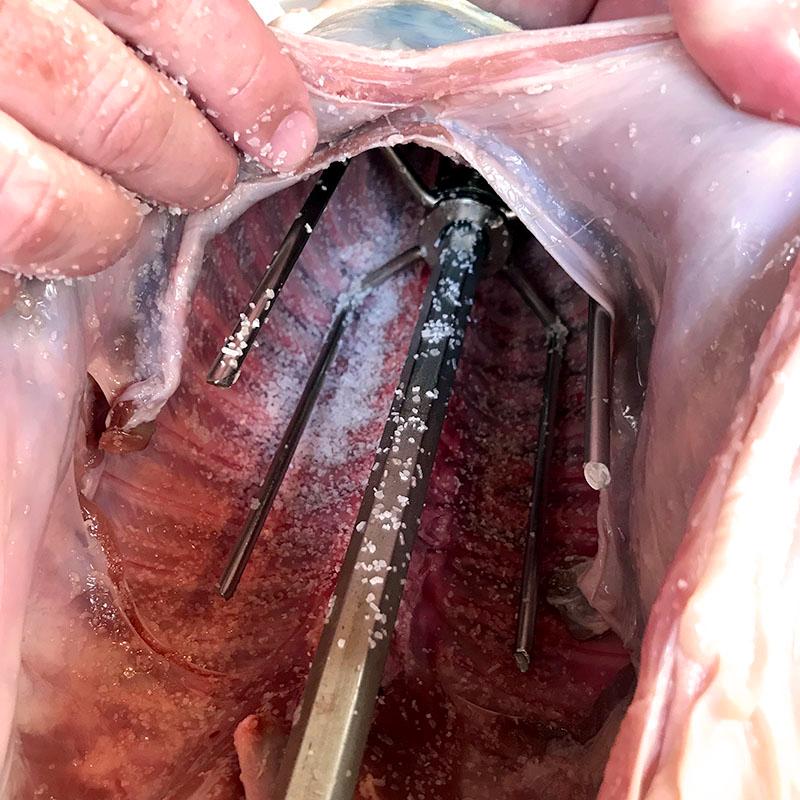
- Slide the modified rotisserie fork over the spit toward the head. Slide the paired prongs around the cheeks, pushing the fork as far in as possible. With enough care, the prongs will not pierce the cheeks. Use the pliers to tighten the thumb screw.
- Slide the final rotisserie fork over the spit toward the tail. Pull the rear legs forward to slide the fork as far in as possible. You may or may not need to pierce the flesh with the prongs to get this final fork all the way into position. Use the pliers to tighten the thumb screw.
With all of the forks positioned and tightened, it is now time to truss the pigs with butcher’s string. A 20-pound pig needs to be tied in three places.
- Tie the rear legs together right above the feet, leaving a long loose end of string, then pull the legs forward and against the body. Run that loose end of string around the body and back to the feet. Tie the legs tightly to the body.

- Tie the front legs together right above the feet, leaving a long loose end of string, then pull the legs forward and against the jaw. Run that loose end of string around the neck and back to the feet. Tuck the ears flat under the string so that they do not burn. Tie the legs tightly to the neck.
- Secure the front knees to the chest with one last length of string passed around the legs and body.
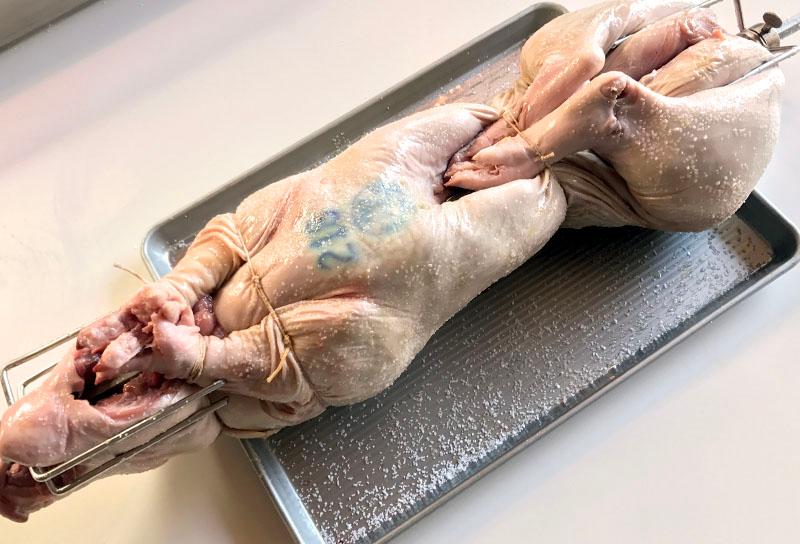
- Generously season the outside of the pig with kosher salt. Apply a little olive oil if necessary to get the salt to stick to the skin.
How do I cook the pig?
The pig should be roasted slowly with indirect heat while the subtle flavor of smoke infuses the meat. Because it is so young and tender, a suckling pig is very forgiving to cook. And, if you overcook it a little, it will still be fantastic. Depending upon the size of the pig and the fire, the roasting time is between 2 and 4 hours. It is typically closest to 3 hours using the described methods and a 20-pound pig.
Following are instructions for roasting the suckling pig on the Kalamazoo Hybrid Fire Grill and on the Gaucho Grill. For both grill types, the most important thing is to keep the wood fire offset from the pig to create indirect heat. An indirect heat is needed as we slowly roast and infuse the meat with a subtle smoky flavor.
Cooking on the Hybrid Fire Grill:
- Remove all of the grill grates.
- Flip up the warming rack to hang from the hooks out of the way of the rotisserie (or simply remove it).
- Using two splits of hardwood, place each into a channel of the Hybrid Fire Grilling Drawer, running from front to back. Light the ignition burner, followed by each of the primary burners. Set the primary burners to HIGH. Leave the hood open while the grill preheats and the wood catches fire.
- Once the wood is burning, put on a pair of protective grilling gloves, and use a pair of long grilling tongs to carefully reorient the wood so that it lies across the front of the grilling drawer. This will create an indirect heat source so that the fire will not be directly underneath the pig as it cooks.
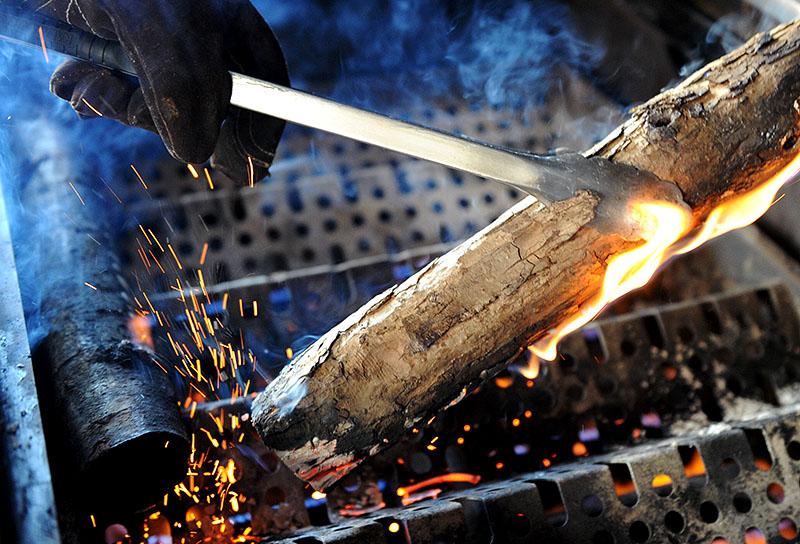
- Turn off the primary burners, but leave the ignition burner running on HIGH.
- Mount the spit (with the pig) into the grill and start the rotisserie spinning to begin cooking.
- You will be cooking with grill hood open some of the time, and closed some of the time. When the flames of the fire are large, the hood should be open. This will keep the heat gentle enough to prevent burning the skin. When the flames are small, or the wood is just smoldering, the hood should be closed.
- Before the fire dies, add two new splits of wood across the front of the grill. Small splits or limbs work best at this point. You will likely need to repeat the process of adding wood multiple times as the pig roasts.
- It won’t take long for the skin to begin to brown. You want to create a nice, crispy skin, but you do not want it to blister too early, so it is important to manage the fire and monitor whether the hood should be open or closed.
- Check the temperature of the meat occasionally. Stop the rotisserie and insert an instant-read meat thermometer into the thickest part of the shoulder. The pig should be removed from the grill when the temperature reads 160°F. As you approach this temperature, make sure the skin is crisping up. Once the meat registers 140°F internal temperature, the skin should be well on its way. If it is not, you can boost the heat by adding some wood chunks to the fire (still at the front of the grill) and closing the hood. Strategically place the wood chunks to boost the heat where you need it most.
- Once you’re reached 160°F, put on the protective grilling gloves, turn off the rotisserie motor, and remove the spit from the grill. Let the pig rest for 30 minutes before removing the spit and serving.
Cooking on the Gaucho Grill:
- Remove all of the grill grates from the grilling rack.
- Stack 6 splits of hardwood in 3 layers – log-cabin-style – on the fire grate. You can learn more about cooking fires and fire management for the Gaucho Grill from our Gaucho Grilling Guide.
- Light the burners to start the fire. Turn off the burners after about 5 minutes, or once the fire is strong.
- Once all of the wood is burning, put on a pair of protective grilling gloves, and use a pair of long grilling tongs to carefully reorient the wood to lie across the back wall of the firebox. This will create an indirect heat source so that the fire will not be directly underneath the pig as it cooks.
- Mount the spit (with the pig) into the grill and start the rotisserie spinning to begin cooking.
- Raise the rotisserie spit (and grill rack) to the highest level where the pig still easily clears the upper structure of the gill.
- Before the fire dies, add two new splits of wood on top of the fire at the back of the grill. You will likely need to repeat the process of adding wood multiple times as the pig roasts.
- It won’t take long for the skin to begin to brown. You want to create a nice, crispy skin, but you do not want it to blister too early, so it is important to manage the fire.
- Check the temperature of the meat occasionally. Stop the rotisserie and insert an instant-read meat thermometer into the thickest part of the shoulder. The pig should be removed from the grill when the temperature reads 160°F. As you approach this temperature, make sure the skin is crisping up. Once the meat registers 140°F internal temperature, the skin should be well on its way. If it is not, you can boost the heat by lowering the pig closer to the fire. You can also carefully rearrange the fire to make the heat more intense toward one end or the other if necessary.
- Once you’re reached 160°F, put on the protective grilling gloves, turn off the rotisserie motor, and remove the spit from the grill. Let the pig rest for 30 minutes before removing the spit and serving.
How do I serve the pig?
That is the most difficult question to answer in this entire grilling guide. The answer depends on you and your guests, and how you collectively feel about a whole pig presented in the center of the table. We like to cut away the butcher’s string, and then remove the spit and forks. Place the beautiful, brown, crispy and tender pig on a large enough carving board. Use a sharp knife to cut through the skin in a crosshatch pattern, and then place it in the center of the table. Let everyone dig in with their hands to pull off their favorite morsels. We suggest a small dipping bowl of Bourbon Carolina Barbecue Sauce on each guest’s plate.
If you wish to serve the finished dish in a more gentile manner, we suggest cutting up the skin and then pulling all of the meat from the bones using a combination of your fingers and a boning knife. Treat it all as you would a pulled pork butt. Mix the meat together with the cut up crispy skin on a platter. You can pour over a little barbecue sauce, or you can serve a sauce on the side.
